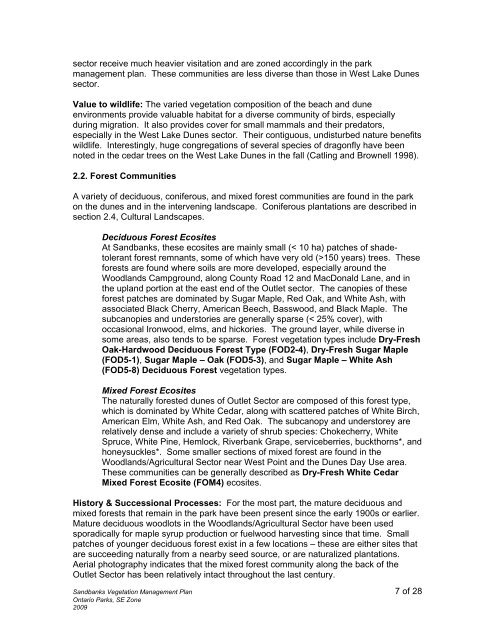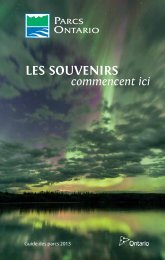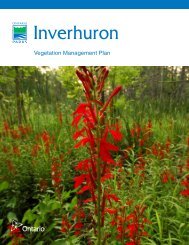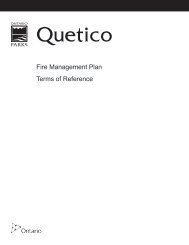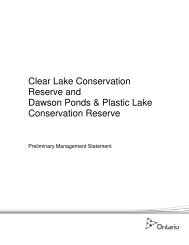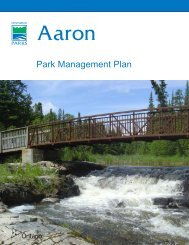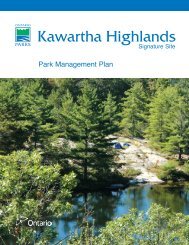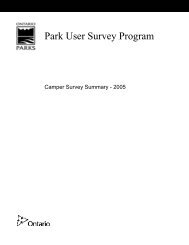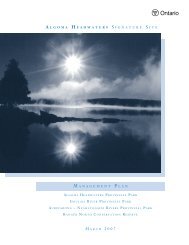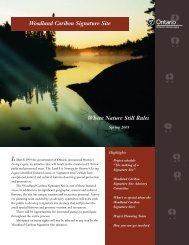Sandbanks Draft Veg Mgmt Plan - Ontario Parks
Sandbanks Draft Veg Mgmt Plan - Ontario Parks
Sandbanks Draft Veg Mgmt Plan - Ontario Parks
Create successful ePaper yourself
Turn your PDF publications into a flip-book with our unique Google optimized e-Paper software.
sector receive much heavier visitation and are zoned accordingly in the park<br />
management plan. These communities are less diverse than those in West Lake Dunes<br />
sector.<br />
Value to wildlife: The varied vegetation composition of the beach and dune<br />
environments provide valuable habitat for a diverse community of birds, especially<br />
during migration. It also provides cover for small mammals and their predators,<br />
especially in the West Lake Dunes sector. Their contiguous, undisturbed nature benefits<br />
wildlife. Interestingly, huge congregations of several species of dragonfly have been<br />
noted in the cedar trees on the West Lake Dunes in the fall (Catling and Brownell 1998).<br />
2.2. Forest Communities<br />
A variety of deciduous, coniferous, and mixed forest communities are found in the park<br />
on the dunes and in the intervening landscape. Coniferous plantations are described in<br />
section 2.4, Cultural Landscapes.<br />
Deciduous Forest Ecosites<br />
At <strong>Sandbanks</strong>, these ecosites are mainly small (< 10 ha) patches of shadetolerant<br />
forest remnants, some of which have very old (>150 years) trees. These<br />
forests are found where soils are more developed, especially around the<br />
Woodlands Campground, along County Road 12 and MacDonald Lane, and in<br />
the upland portion at the east end of the Outlet sector. The canopies of these<br />
forest patches are dominated by Sugar Maple, Red Oak, and White Ash, with<br />
associated Black Cherry, American Beech, Basswood, and Black Maple. The<br />
subcanopies and understories are generally sparse (< 25% cover), with<br />
occasional Ironwood, elms, and hickories. The ground layer, while diverse in<br />
some areas, also tends to be sparse. Forest vegetation types include Dry-Fresh<br />
Oak-Hardwood Deciduous Forest Type (FOD2-4), Dry-Fresh Sugar Maple<br />
(FOD5-1), Sugar Maple – Oak (FOD5-3), and Sugar Maple – White Ash<br />
(FOD5-8) Deciduous Forest vegetation types.<br />
Mixed Forest Ecosites<br />
The naturally forested dunes of Outlet Sector are composed of this forest type,<br />
which is dominated by White Cedar, along with scattered patches of White Birch,<br />
American Elm, White Ash, and Red Oak. The subcanopy and understorey are<br />
relatively dense and include a variety of shrub species: Chokecherry, White<br />
Spruce, White Pine, Hemlock, Riverbank Grape, serviceberries, buckthorns*, and<br />
honeysuckles*. Some smaller sections of mixed forest are found in the<br />
Woodlands/Agricultural Sector near West Point and the Dunes Day Use area.<br />
These communities can be generally described as Dry-Fresh White Cedar<br />
Mixed Forest Ecosite (FOM4) ecosites.<br />
History & Successional Processes: For the most part, the mature deciduous and<br />
mixed forests that remain in the park have been present since the early 1900s or earlier.<br />
Mature deciduous woodlots in the Woodlands/Agricultural Sector have been used<br />
sporadically for maple syrup production or fuelwood harvesting since that time. Small<br />
patches of younger deciduous forest exist in a few locations – these are either sites that<br />
are succeeding naturally from a nearby seed source, or are naturalized plantations.<br />
Aerial photography indicates that the mixed forest community along the back of the<br />
Outlet Sector has been relatively intact throughout the last century.<br />
<strong>Sandbanks</strong> <strong>Veg</strong>etation Management <strong>Plan</strong> 7 of 28<br />
<strong>Ontario</strong> <strong>Parks</strong>, SE Zone<br />
2009


